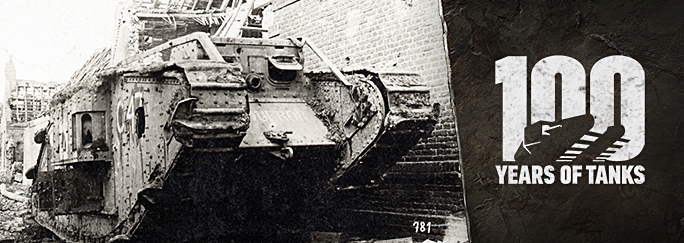The Centenary of Tanks. The Cornerstones

The year is 1916. For many months soldiers have engaged in the horrors of trench warfare, resulting in large-scale attacks that lead to thousands of dead soldiers for at most a few hundred metres gained. Day by day, week by week, the war toiled on, seemingly without end. However, the solution was ahead: a new revolutionary weapon – a demon of technological warfare that was being developed in British armouries, and would one day become known as the tank.
Four technological inventions linked by one ground were required to create this armoured vehicle. They are as follows:
The Track Running Gear
Historians are not sure who was the first to invent tracks. Some of them believe that the French engineer d'Hermand introduced the “new type track” in 1713 – this track featured a chain of log rollers. Others believe that Richard Lovell Edgeworth was the first to lock track wheels with chains half a century later. Though, he did not patent his invention, nevertheless, the new suspension principle has never been forgotten.
Starting from the early 19th century, dozens of engineers, working independently of each other, worked on creating and improving different track designs. Long before creating the first tanks, track suspensions had spread worldwide (for example, the scientist Robert Scott used it in the Antarctic).
Many tracked vehicles were used during World War I. The blueprints were often based on manufactured vehicles, and some of them were rather weird. For example, according to a certain blueprint, it was planned to equip the Ilya Muromets heavy bomber with tracks so it could take off from any surface.
Tracks unlocked the potential of standard wheels by increasing their crossing capacity. However, they would have never become so popular had it not been for the steam engine.
The Engine
The first steam turbines were developed a long time ago in the Middle Ages. The Scotsman James Watt patented the first steam machine in the 18th century. Although it had a rather limited capacity (10 horsepower), that was enough to change the world.
Engineers tried to equip railless vehicles (including military ones) with steam engines apart from steam trains. In the middle of the 19th century, steam trucks were used for the purpose of military supply. Nevertheless, their drawbacks had become obvious – significant consumption and a large boiler increased the vehicle size severely. The combustion engine was the very thing to improve the situation, as it had been improved upon by many talented engineers for more than a century.
At the same time, chemists were developing a proper fuel for the new engine. First of all, it was planned to use spirits or turpentine. However, crude oil refining has replaced them. Although the Russian scientist Dmitry Mendeleev was rather doubtful about using petroleum, it was adopted. The German engineers G. Daimler and W. Maybach developed the gasoline carburettor engine, while Rudolf Diesel became famous seven years later for developing an engine of his own design (take a guess as to what he named it!). The age of steam engines was coming to a close, and the future tanks had received their "heart”. But for the tanks to survive the hazards of armed combat, they would also need to be protected from enemy bullets and shells.
Armour
Engineering successes in the 19th century facilitated the development of metallurgical engineering and armoured plating for tanks. Originally used for fleet armouring and fortification purposes, in 1856, the Russian mechanic Vasily Pyatov invented the first rolling mill for armour plates. One year later, the Belgium military engineer Alexis Brialmont suggested equipping the Antwerp fortress with armoured turret emplacements. Later, fortresses in many countries would be equipped with such turrets.
Local wars of the late 19th century proved that national defences should constantly be improved – otherwise, a well-armoured enemy could easily breach a nation's fortifications. To provide extra defence, concrete armoured plates became a popular method of reinforcing defensive positions. From 1885 through 1887, the engineers Gruson and Schumann invented the 5.3 cm L/24 Fahrpanzer mobile artillery piece. Soldiers felt rather critical about this "vehicle", since they felt a self-propelled mobile artillery piece was not comparable to a real emplacement.
The three above-mentioned inventions would never have resulted in a complete tank, but for the successes achieved by countless military engineers.
Armament
High-quality steel became very popular two centuries ago, which opened up new horizons for engineers. The rifled barrel, recoil system, and breech reloading had been invented, each of which improved the destructive capability of the gun significantly. The first Maxim machineguns became known all over the old world in 1893. Initially disliked by more conservative members of Europe's military high command – they pointed out its rather high ammo consumption and vulnerability to artillery fire – its high rate of fire of 600 rounds per minute was also a significant reason for its adoption. All leading countries embarked on purchasing and manufacturing machineguns to bolster their nation's fighting capabilities.
Later, the first armoured vehicles would be equipped with machineguns and even high-calibre guns. Again, military men of the leading countries of the time were not interested in these vehicles. If someone had invented the tank at the turn of the 20th century, the project would not have been successful.
The four above-mentioned inventions required one linking element: a particular incentive for inventing the tank. Unfortunately, this incentive appeared very soon.
The Fifth Element
Trench warfare was the impetus for the development of the tank. By digging themselves in, armies were capable of improving their defences significantly. The development of the machinegun also meant that a single machinegun team was able to prevent an entire regiment from advancing. “Battalions attacked one after another just to prove that frontal assaults only result in massive casualties…and some Medals for Bravery awarded to those who survived” said a contemporary of the time. In 1916, ten British Vickers machineguns fired around a million rounds of ammunition during a single battle, showcasing the destructive power of this deadly technology.
The no man's land between the opposing forces was a real nightmare! Rampant earth, pock-marked with overlapping shell craters, many of which were flooded, and reinforced with miles of barbed wire made this landscape nearly impossible to traverse. An infantryman could hardly cross such deadly terrain without assistance. What was needed was a new machine to help break the gridlock of trench warfare – what was needed, was the tank!
Sources:
Bakhurin YU. A., Belash Ye. YU. Velikaya voyna 1914–1918: summa tekhnologiy // Ekspert. 2014. № 31–33. S. 61-65.
Belash Ye. YU. Mify Pervoy mirovoy. M., 2012.
Beresnev P. O. i dr. Statisticheskaya model' vybora geometricheskikh parametrov, massoinertsionnykh, moshchnostnykh i skorostnykh kharakteristik gusenichnykh transportno-tekhnologicheskikh mashin // Trudy NGTU im. R. Ye. Alekseyeva. 2016. № 1. S. 109–164.
Fedoseyev S. L. Tanki Pervoy mirovoy. M., 2012.
Yudin S. 600 vystrelov v minutu: nelogkiy put' pulemota k priznaniyu // Warspot. 22.06.2015. http://warspot.ru/3352-600-vystrelov-v-minutu-nelyogkiy-put-pulemyota-k-priznaniyu.
Yakovlev Ye. A. O sovremennoy sukhoputnoy fortifikatsii // Vestnik Voyenno-inzhenernoy akademii Krasnoy Armii imeni V. V. Kuybysheva. Vyp. 32. M., 1941. S. 9.
Keep history alive, Commanders!






